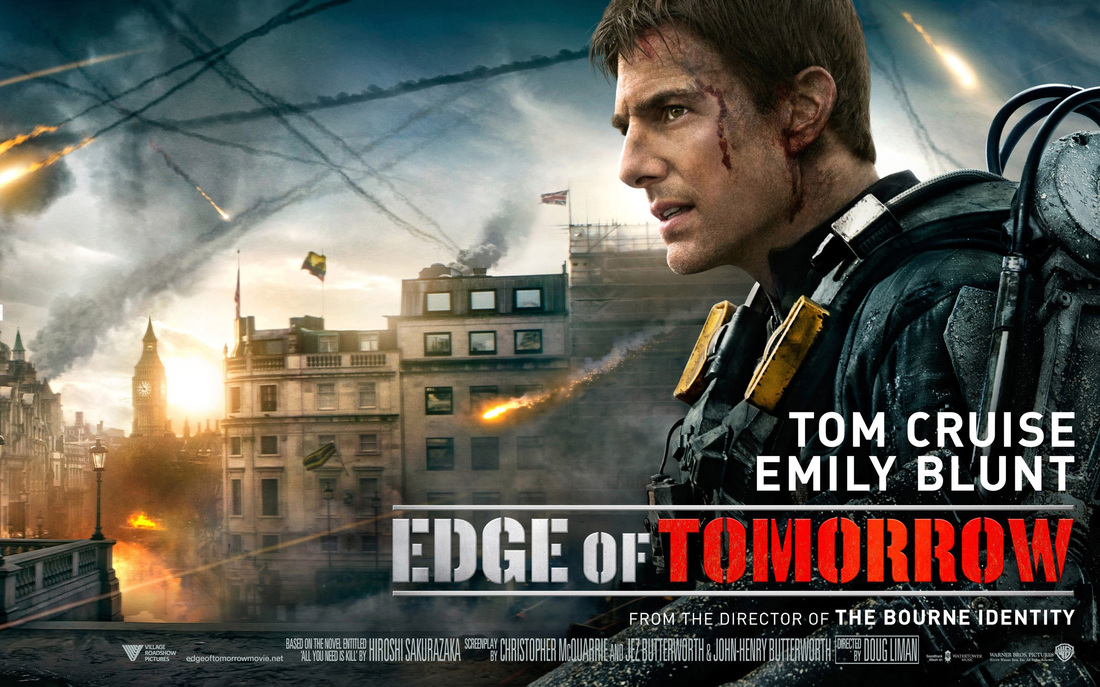Edge of Tomorrow is the surprise of the summer: it’s playful, beguiling, and self-aware, all at once. Yes, it begins with standard cyborg-style armor and loads of CGI, but the film’s real tricks lie in its self-deprecating humor and commitment to subverting audience expectations.
Edge of Tomorrow is a delight, even if it loses momentum in its final act. While it begins and ends with Hollywood clichés (ex: cyborg-style armor, loads of CGI), the sweet, gooey middle is the best thing you’ll watch all summer.
We start with a nervous, cowardly Major Cage (Cruise), the pretty boy military officer who can work a room of journalists but can’t handle the sight of blood. It turns out a giant, Octopus-like race of aliens (they call ‘em “Mimics”), has taken over nearly all of Western Europe, save England. Now, a joint American-British army (including Cage) will airdrop onto the shores of France, fighting back the Mimic scourge and reenacting WWII’s D-Day.
Things don’t go particularly well the first time, as the Mimics have somehow anticipated the humans’ every move, ambushing the attack from multiple sides and demolishing the human force in under five minutes. Tomorrow even treats us to a particularly harrowing image, where Cruise’s gorgeous face is half blown off by his own bomb.
And yet…
Major Cage then wakes up 24 hours earlier, before the invasion. He goes on to relive the same day, with all the same beats, except that only he knows what’s about to happen.
For Groundhog veterans, the first 30 minutes might seem a bit slow, like a workplace tutorial reviewing standards of conduct and respect for employees. Happily, however, Tomorrow becomes smarter, faster, and far more clever after just three or four resets, mixing physical comedy, riddles, and urgency for an extremely satisfying hour of entertainment.
The film’s first trick is making a repetitive battle scene as fun as the day-long date from Groundhog Day. In the Bill Murray version, we laugh as the man revises his drink choice to impress a lady. With Cruise, we chuckle as our action star jumps, then dives, then sprints, then walks—a series of moves honed through exhaustive trial and error. But Tomorrow goes a step further, mixing action with conversation, revised gunplay with modified flirtation. Cruise doesn’t just learn the best path through the battlefield, but also the best rhetorical strategies for convincing superior officers or talking down nervous soldiers.
The film also plays with perspective. One moment, we think we—like Major Cage—are experiencing a scenario for the first time. “You always die here!” he then shouts at his comrade, whereupon she ducks, and we—like her—exhale in surprise and relief as a helicopter hurtles by just above. Moments like these keep the action fresh and novel, even as we see the same alien or same explosion for the 13th time.
As you might expect, the science behind all of this is a little dicey. I won’t say much more (I don’t want to spoil anything), but let’s just say it’s both complicated enough and intriguing enough that you’ll likely go along with the explanation.
Instead, it’s the film’s final five minutes that commit the worst crime of logic. The movie’s resolution reeks of focus groups and Hollywood hand-holding, which is a bummer next to all the creative, surprising choices present in the film’s second act. It’s a shame, but it’s a small enough sin that it doesn’t retroactively ruin the movie (I’m looking at you, Source Code)—a plot development you can’t explain but you can certainly shrug off.
In the end, Edge of Tomorrow earns its place next to Groundhog Day, a film that justifies all the repetition on the strength of pure cleverness. Tomorrow might make you watch the same scene over two dozen times, but once you’re done, your first instinct will be to reset and watch it all over again.



 RSS Feed
RSS Feed
